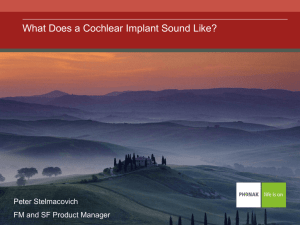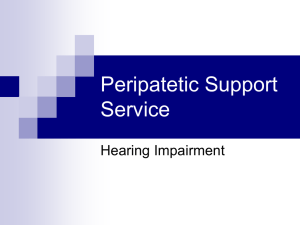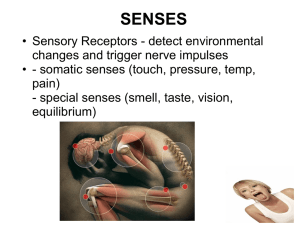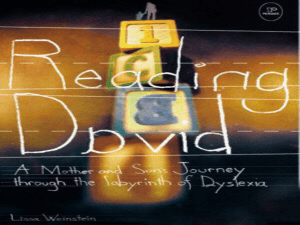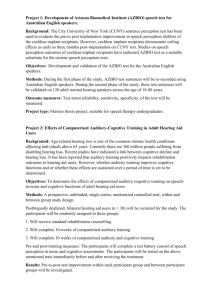Chapter 11 Clinical Application
advertisement
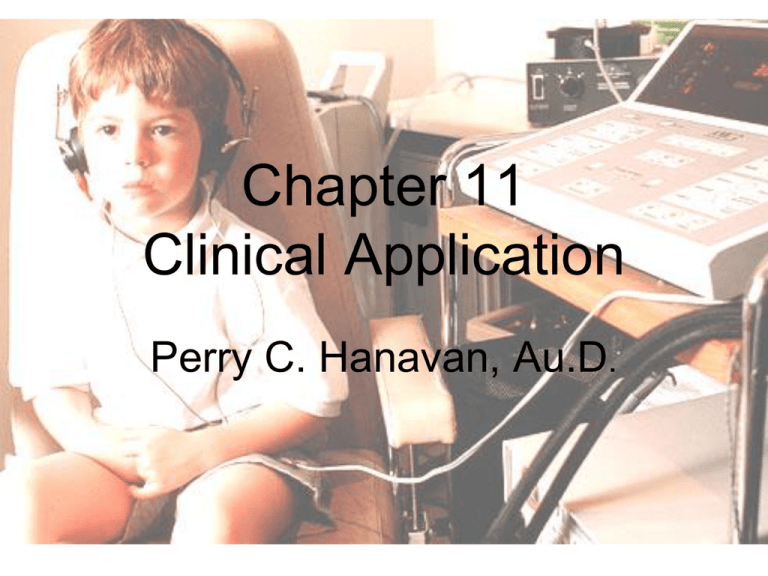
Chapter 11 Clinical Application Perry C. Hanavan, Au.D. Outer Ear Resonance • Influence of pinna (p) • Influence of ear canal (c) • Combine influence (t) • At 3000 Hz, the final amplification (t) is 20 dB Transformer/Amplifier • Area ratio – Thumbtack • Lever – crowbar Middle Ear Muscles • Tensor tympani – Attached to malleus – Innervated by V, trigeminal nerve • Stapedius – Attached to stapes – Innervated by VII, facial nerve • Middle Ear Muscle Function: – Protect inner ear from excessive sound levels • When ear exposed to sound levels above 70 dB, the muscles contract, decreasing amount of energy transferred to inner ear Hearing Loss • Audibility • Identification • Signal to noise ratio (SNR loss) Audibility Hair Cells • Outer Hair Cells • Inner Hair Cells • OHC movie Hair Cells • Outer Hair Cells • Inner Hair Cells • OHC movie Generate distortions Traveling Waves • • • • Traveling wave Basilar membrane Traveling Wave info Cochlear Traveling Wave Central Auditory Path Identification/Recognition • Hearing loss affects the ability to correctly identify or label sound(s) – Vowels relatively easy – Consonants more difficulty to identify • Place of production errors common • High frequency consonants (sibilants) extremely difficult to identify QuickSin/BKBSIN SNR Loss UWO Plurals Test • Test designed to test high frequency consonant detection, and assist with determining audibility. Phoneme Perception Test CI • CI offers one treatment option • Phonak remote Dynamic FM best for classroom noise conditions • Currently, addition of classroom amplification with CI with FM shows no benefit Siemens Hearing Test (Free) iOS: iTalkAtMoog Ling 6 (iOS)($1.99) Cochlear HOPE Words Lite and HD Cochlear HOPE App (Apple) • Cochlear HOPE program • Adopted from Speech Sounds and Speech Sounds Vowels • Listen to a word and matching their speech production to what they heard. • Vocabulary development also facilitated • Each letter of alphabet has twenty different flashcards • In some instances, letter may have two different speech sounds (for example, “A” as in “way” or “A” as in “cat”) Baldi (iOS App $4.99) Auditory Verbal iPad ($3.99) Hearing Aids • Hearing aids • FM remote microphones • Phonak Dynamic FM best for background noise conditions • Extended high frequency bandpass hearing aids (250-10,000 Hz) • Non-linear frequency compression hearing aids Phonak Dynamic FM Recievers Non-linear Freq Compresion Classroom Amplification • Phonak Dynamic FM • Phonak Dynamic FM in Classroom Otitis Media Prevalent among children birth to 6. At-risk children for OM: • Down Syndrome • Cleft Palate (cranial facial) • Treacher-Collins (cranial facial) • 2nd-hand smoke • Day-care • Low income (Inner city, Native Americans, etc.) • Bottle fed rather than breast fed • Allergies • Other infections (upper respiratory) • Immune suppression (HIV, AIDS, etc.) • Pacifier • Family history OME Tendencies • • • Language impairments Poor phonetic processing At-risk for developmental delays in perceptual and phonemic awareness, thus leading to difficulties with higher level language functioning and reading Specific Language Impairment • • Characterized by difficulty with language that is not caused by: • • • • known neurological, sensory, intellectual, or emotional deficit. Can affect the development of: • • • • vocabulary, grammar, and discourse skills, with evidence that certain morphemes may be especially difficult to acquire (including past tense, copula be, third person singular). SLI (cont.) • • • • • Children with SLI may be intelligent and healthy in all regards except in the difficulty they have with language. They may in fact be extraordinarily bright and have high nonverbal IQs. Children with SLI usually learn to talk late child 3 or 4 years of age with limited vocabulary and short utterances. Likely to be the kinds of kids who are told by parents and teachers they are smart but unmotivated and they just need to try harder. SLI (cont.) • • • • Difficulty processing rapid acoustic speech cues (temporal processing problem) Difficulty identifying formant transitions, thus difficulty identifying phonemes Children of the Code Paula Tallal (Temporal spectral deficits) Dyslexia • • • • • • Categorical perception difficulty Reading ability is significantly lower Difficulty perceiving consonant contrasts Confuse sounds phonetically similar May have deficits in processing the temporal order of acoustic information (difficulty identifying phonemes and judging the order in which the phonemes are heard) Difficulty segmenting, discriminating and identifying speech sounds Types of Dyslexia • Developmental phonological dyslexia difficulty with nonword reading. – Changing the initial and middle letters of a word. – Examples are mana (mama) and aufo (auto). • Developmental surface dyslexia - difficulty in reading irregular words. – 25% English words are irregular, which means that they violate English spelling-to-sound word rule. – Examples: pretty, bowl, and sew. Etiology of Dyslexia • Heredity: – Family gene carries the disorder – Studies have shown that males are four times more likely to have a reading disorder than a female; – However, perhaps a male’s behavior contributes to this as it brings forth the disorder to a teacher’s attention more easily. – Perhaps females can more readily compensate Etiology of Dyslexia • Environment: – Limited English vocabulary • English as second language students. – Difficulty understanding phonemics. – Children of poverty – Children with parents with low reading levels – Students with speech or hearing impairments Articulatory Problems Categorized into subgroups: 1. Those with speech perception difficulties 2. Those with normal speech perception • • • Subjects asked to identify words that contrasted phonemes /s/ and /S/. In this test, a subgroup of articulation-disordered children were unable to identify the test stimuli appropriately (seat vs. sheet). Subjects asked to identify words that contrasted the phonemes /s/ and /theta/, In words sick and thick, and none of the articulation-disordered children were able to identify these words appropriately whereas children without disorder could. Important to assess speech perception abilities prior to initiating articulation therapy Rvachew S & Jamieson DG. (1989). Perception of voiceless fricatives by children with a functional articulation disorder. J Speech Hear Disord.; 54(2):193-208. Reading Disorders • Difficultly reading or understanding material within a reading. • Most have problems with their phonemic (sound/symbol relationships) awareness development. – Have difficult time putting together letters to make a sound.

